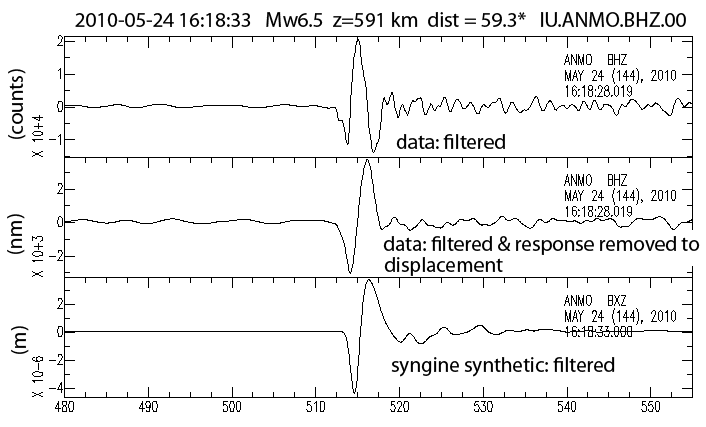Summary
The Synthetics Engine (Syngine) service provides access to custom tailored synthetic seismograms for selected Earth and Mars models.
Quicklinks
Description
The IRIS Synthetics Engine (Syngine) is a webservice that quickly returns synthetic seismograms custom requested by the user. Syngine utilizes locally stored precalculated TB scale databases of Green’s Functions for several different 1D reference Earth models and selected Mars models from the ETH Zurich’s precomputed Green’s functions databases. The DMC Green’s Functions were generated by Tarje Nissen-Meyer & colleagues using AxiSEM (Nissen-Meyer et al., 2014), an axi-symmetric spectral element method for 3D (an-)elastic, anisotropic and acoustic wave propagation in spherical domains. It requires axisymmetric background models and runs within a 2D computational domain, thereby reaching all desired highest observable frequencies (up to 2Hz) in global seismology. The requested synthetic seismograms are calculated using Instaseis (van Driel et al., 2015), a python library built for storing wavefield databases with a fast extraction algorithm. By using Instaseis and obspy, Syngine provides users with fully customizable synthetic seismograms for any source-receiver combination with a variety of source options including point source or user supplied moment tensors (or GCMT, Earth models), support for finite-fault models (Earth models), variable width and custom source-time functions.
How do download synthetics
Building an http request, sample queries & documentation
Command line downloading with FetchSyn
Current Syngine Earth models stored at IRIS DMC
| Model name | resolution (s) | database dt (s) | default dt (s) | length (s) | source depths (m) | components | description | database size | 1D model |
|---|---|---|---|---|---|---|---|---|---|
| ak135f_1s | 1-100 | 0.255 | 0.05 | 1815 | 0-750000 | vertical | AK135 with density & Q of Montagner & Kennet(1996) | 1.4 TB | link |
| ak135f_2s | 2-100 | 0.525 | 0.1 | 3600 | 0-750000 | vertical and horizontal | AK135 with density & Q of Montagner & Kennet(1996) | 1.3 TB | link |
| ak135f_5s (default) | 5-100 | 1.278 | 0.25 | 3904 | 0-750000 | vertical and horizontal | AK135 with density & Q of Montagner & Kennet(1996) | 121 GB | link |
| iasp91_2s | 2-100 | 0.483 | 0.1 | 3699 | 0-700000 | vertical and horizontal | IASP91 | 2.0 TB | link |
| prem_i_2s | 2-100 | 0.512 | 0.1 | 3610 | 0-750000 | vertical and horizontal | isotropic PREM | 1.3 TB | link |
| prem_a_2s | 2-100 | 0.512 | 0.1 | 3610 | 0-750000 | vertical and horizontal | anisotropic PREM | 1.4 TB | link |
| prem_a_5s | 5-100 | 1.295 | 0.25 | 3904 | 0-750000 | vertical and horizontal | anisotropic PREM | 123 GB | link |
| prem_a_10s | 10-100 | 2.44 | 0.5 | 17999 | 0-700000 | vertical and horizontal | anisotropic PREM | 86 GB | link |
| prem_a_20s | 20-100 | 4.869 | 1.0 | 1796 | 0-671000 | vertical and horizontal | anisotropic PREM | 0.9 GB | link |
InSight Mars models from ETH Zurich database
The InSight mission presents 2 Syngine databases for Mars and based on the 3 Science papers on crust, mantle and core. The models are based on two different inversion methods taking into account constraints from mineralogy and thermodynamics. The inversion data are:
- body wave picks (P, S, PP, SS, PPP, SSS, ScS)
- Mean density of the planet and moment of inertia
- 2nd order tidal Love number k2
- Receiver function-derived crustal layering
The first model, InSight_KKS21GP, is based on a “geophysical” inversion allowing for 6 different bulk compositions, using an adiabatic temperature profile below the lithosphere (Khan et al. 2021). The second model, InSight_KKS21GD, is based on a “geodynamic” inversion that simulates 4 billion years of thermal convection, but is restricted to a single compositional model (described in SM8 in Stähler et al., 2021a). Both models show the same misfit against data, but are just two models out of 200 results of a MCMC (Mars Climate Modeling Center) run (for full dataset information see Stähler et al., 2021b). Since these inversions did not use receiver functions to constrain the crustal profile, a crust similar to that of Knapmeyer-Endrun et al., 2021) was added manually.
The attenuation structure has been fixed to:
- Qmu=100 in the upper crustal layer 0-10 km (to suppress reverberations above the strong inner crustal boundary)
- Qmu=300 between 10 km and 180 km
- Qmu=600 in the mantle below 180 km
- Qkappa=1e5
at reference period of 1 second
Note that the synthetic data shows a relatively clear surface wave train up to the highest frequencies, which in reality would be suppressed by scattering.
| Syngine model name | ETH database name | Model name | resolution (s) | database dt (s) | default dt (s) | length (s) | components | Model info |
|---|---|---|---|---|---|---|---|---|
| mars_insightkks21gd_2s | InSight_KKS21_GD | InSight_KKS21GD | 1-100 | 0.472 | 0.1 | 3600 | vertical and horizontal | info |
| mars_insightkks21gp_2s | InSight_KKS21_GP | InSight_KKS21GP | 1-100 | 0.496 | 0.1 | 3600 | vertical and horizontal | info |
Selected Mars models from ETH Zurich database ( http://instaseis.ethz.ch/marssynthetics/ )
| Syngine model name | ETH database name | Model name | resolution (s) | database dt (s) | default dt (s) | length (s) | components | Model info |
|---|---|---|---|---|---|---|---|---|
| mars_eh45tcold_1s | EH45Tcold_1s | EH45Tcold | 2-100 | 0.25 | 0.05 | 1800 | vertical and horizontal | info |
| mars_eh45tcold_5s | EH45Tcold_5s | EH45Tcold | 5-100 | 1.24 | 0.25 | 18000 | vertical and horizontal | info |
| mars_maak_1s | MAAK_1s | MAAK | 1-100 | 0.245 | 0.05 | 1800 | vertical and horizontal | info |
| mars_maak_5s | MAAK_5s | MAAK | 5-100 | 1.25 | 0.25 | 18000 | vertical and horizontal | info |
| mars_tayak_1s | TAYAK_1s | TAYAK | 1-100 | 0.242 | 0.05 | 1800 | vertical and horizontal | info |
| mars_tayak_5s | TAYAK_5s | TAYAK | 5-100 | 1.183 | 0.25 | 18000 | vertical and horizontal | info |
Syngine AxiSEM synthetics are complete:
- radiation pattern
- attenuation
- discontinuities appropriately honored
Syngine is flexible:
- Supports both Earth and Mars models.
- Any source-receiver combination for any source depth down to 700 km.
- Accepted source types: moment tensor, double couple, forces
- Vertical, North, East, Radial or Transverse components (or any combination)
- displacement, velocity, or acceleration. (default is displacement in meters)
- Fully loaded headers so users can mimic data, e.g. origin time & trace start time
- zip archive of SAC files or miniseed output formats
Syngine is smart:
- Given network and station name(s), syngine will use IRIS fedcatalog webservices to look up receiver location(s) across FDSN data centers.
- Syngine can accept event IDs (e.g. from GCMT) for origin and moment tensor parameters for the Earth models and event IDS from the mars-event web service for the Mars models.
- Syngine can window traces based on travel times for any phase.
Syngine is fast:
Since the databases for models are precomputed (for the Earth models, they a running “hot” on IRIS servers, explanation), only Green’s Function extraction, parameter look-ups and basic processing (e.g. resampling, source convolutions) are done. Requests can be fulfilled as fast as fractions of a second, though connection bandwidth, load from other user requests, and complexity of request can add significant time.
Building a request
Request details/parameters and a URL builder are available.
Example requests:
- Using the default Earth model
https://ds.iris.edu/ds/products/syngine/syngine/1/query?network=IU&station=ANMO&components=Z&eventid=GCMT:M110302J&label=MyExample
Example output: syngine-ak135f_5s-2002-11-03t22_13_28-myexample
Example SAC file: MyExample_IU.ANMO.SE.MXZ.sac.zip
note: location code = SE (Synthetics Engine)
- Using the Mars mars_maak_5s model and XB.ELYHK Mars station
https://ds.iris.edu/ds/products/syngine/1/query?model=mars_maak_5s&format=saczip&network=XB&station=ELYHK&sourcedepthinmeters=50000&origintime=2020-01-02T03:04:05&sourcelatitude=0&sourcelongitude=0&sourcedoublecouple=310,15,90,1E19&label=MyExample&nodata=404
Example output: syngine-mars_maak_5s-2020-01-02t03_04_05-myexample.zip
Example SAC file: MyExample_XB.ELYHK.SE.MXZ.sac
note: location code = SE (Synthetics Engine)
Choosing a new sampling rate (dt):
In order to avoid aliasing, downsampling from the database dt is not allowed by Instaseis, only upsampling. If a model has a database dt=0.5, dt=0.1 is allowed, dt=1.0 is not allowed. Detailed examples on resampling
Default source:
By default Instaseis returns the response to a very narrow Gaussian source time function with a full-width at half-max of approximately two-thirds the shortest period resolved, which is as close to a delta function as possible with AxiSEM.
Geodetic/Geocentric Latitudes:
AxiSEM and Instaseis, which drive Syngine, use geocentric latitudes. For the Earth models, station and earthquake coordinates use geodetic/geographic latitudes. It is common practice in seismology to convert from geodetic/geographic to geocentric latitudes in order to calculate distance using spherical geometry. Syngine does this conversion for the Earth models but maintains the geocentric latitudes for the Mars models.
Headers convention for SAC output
When output is chosen as saczip, the SAC files will have header values populated. Header fields of note for Syngine SAC files are:
| SAC header name | example | description |
|---|---|---|
| AZ | 106.196 | azimuth based on geodetic coordinates for Earth and geocentric coordinates for Mars |
| BAZ | 301.729 | back azimuth based on geodetic coordinates for Earth and geocentric coordinates for Mars |
| DIST | 9.269906e+03 | Distance in km on a sphere |
| EVLA | 28.08 | Source latitude (geodetic for the Earth models and geocentric for the Mars models) |
| GCARC | 8.327261e+01 | Distance in degrees |
| KCMPNM | BXE | Convention for channel name is: sample rate – “X” for synthetics – component |
| KT6 | Earth | The model planet (Earth/Mars) |
| KUSER0 | Syngine | Who generated the synthetic trace |
| KUSER1 | prem | The name of the reference model |
| KUSER2 | 2s | Model resolution limit (see the above tables) |
| OMARKER | -621.5 | Offset time (seconds) of the origin relative to the begin time (KZTIME) |
| STLA | 4.50238 | Receiver latitude (geodetic for the Earth models and geocentric for the Mars models) |
| USER0 | 1e-9 | The SCALE parameter for amplitude scaling. Syngine default units are meters. |
Tutorials:
Using ObsPy to download and compare Syngine & data waveforms
Using FetchData and SAC to compare Syngine synthetics & data:
A small amount of post-processing is required if users wish to directly compare data and synthetics for a given earthquake. Synthetic seismograms from Syngine are calculated as displacement for a point-like source. Comparing to data requires correcting for instrument gain, a finite width source (not performed here), and sometimes filtering. The following example uses the 2010-05-24 Western Brazil 582km deep M6.5 event. FetchData is available here.
# Get data: FetchData -N IU -S ANMO -C BHZ -L 00 -s 2010,05,24,16,18,28 -e 2010,05,24,17,18,28 -o data.mseed mseed2sac data.mseed mv IU.ANMO.00.BHZ.M.2010,144,16:18:28.SAC ANMO.M6.5.dataraw.sac
# Get RESP file: FetchData -N IU -S ANMO -C BHZ -L 00 -s 2010,05,24,16,18,28 -e 2010,05,24,17,18,28 -rd .
# Get synthetic using the GCMT id: wget -O synM6.5.zip "https://ds.iris.edu/ds/products/syngine/1/query?network=IU&station=ANMO&components=Z&eventid=GCMT:C201005241618A&dt=0.05&model=iasp91_2s&label=Tutorial" unzip synM6.5.zip mv Tutorial_IU.ANMO.SE.BXZ.sac ANMO.M6.5.syn.sac
>>SAC #--------- remove response of data trace to displacement ----- r ANMO.M6.5.dataraw.sac rmean w over taper width 0.05 transfer from evalresp to none FREQLIMITS 0.005 0.01 4 8 w ANMO.M6.5.dataRESP.sac #--------- plot the traces ----- r ANMO.M6.5.dataraw.sac ANMO.M6.5.dataRESP.sac ANMO.M6.5.syn.sac bp co 0.1 1.0 qdp off xlim 480 550 p1

Downloading model databases:
Users can download the databases for entire models as .netcdf4 files. Within the model directories are PZ and PX folders for the vertical and horizontal databases, respectively, which have the ordered_output.nc4 files needed to run Instaseis locally.
# Create the appropriate directory structure for Instaseis cd MYMODEL mkdir PX PZ PX/Data PZ/Data
# Download the databases wget -O PZ/Data/ordered_output.nc4 "http://ds.iris.edu/files/syngine/axisem/models/prem_a_20s/PZ/Data/ordered_output.nc4" wget -O PX/Data/ordered_output.nc4 "http://ds.iris.edu/files/syngine/axisem/models/prem_a_20s/PX/Data/ordered_output.nc4"
# Get started using Instaseis with your database locally!
/usr/bin/python
>>> import instaseis
>>> db = instaseis.open_db("/path/to/MYMODEL")
>>> print(db)
InstaseisDB reciprocal Green's function Database (v7) generated with these parameters:
components : vertical and horizontal
velocity model : prem_ani
attenuation : True
dominant period : 20.000 s
dump type : displ_only
excitation type : dipole
time step : 4.869 s
sampling rate : 0.205 Hz
number of samples : 370
seismogram length : 1796.8 s
source time function : errorf
source shift : 34.085 s
spatial order : 4
min/max radius : 5700.0 - 6371.0 km
Planet radius : 6371.0 km
min/max distance : 0.0 - 180.0 deg
time stepping scheme : newmark2
compiler/user : gfortran 4.9.1 by lion on dhcp-10-181-12-69.dynamic.eduroam.mwn.de
directory/url : MYMODEL
size of netCDF files : 598.2 MB
generated by AxiSEM version 60945ec at 2014-10-23T15:35:34.000000Z
>>>
Update history:
- Mars models 2021.03.01: Mars models added
- ak135f_1s: from 2016.01.07 – 2016.02.08: rather than vertical seismograms, the zz-component of the strain tensor was given. (being recalculated as of 2016.02.08)
- prem_a_5s: from 2015.12.10 – 2016.05.16: reference model used was ak135, not prem. (being recalculated as of 2016.05.16)
Citations and DOIs
To cite the IRIS DMC Data Products effort:
- Hutko, A. R., M. Bahavar, C. Trabant, R. T. Weekly, M. Van Fossen, T. Ahern (2017), Data Products at the IRIS‐DMC: Growth and Usage, Seismological Research Letters, 88, no. 3, https://doi.org/10.1785/0220160190.
To cite the source of this product:
- Khan et al. 2021. Upper mantle structure of Mars from InSight seismic data. Science 373 (6553): 434-438; doi:”
https://doi.org/10.1126/science.abf2966”:https://doi.org/10.1126/science.abf2966
- Knapmeyer-Endrun et al., 2021. Thickness and structure of the martian crust from InSight seismic data. Science 373 (6553): 438-443; doi:”
https://doi.org/10.1126/science.abf8966”:https://doi.org/10.1126/science.abf8966
- Stähler et al., 2021a. Seismic detection of the martian core. Science 373 (6553): 443-448; doi:”
https://doi.org/10.1126/science.abi7730”:https://doi.org/10.1126/science.abi7730
- Stähler et al., 2021b. Interior Models of Mars from inversion of seismic body waves (Version 1.0). IPGP Data Center; doi:”
https://doi.org/10.18715/IPGP.2021.kpmqrnz8”:https://doi.org/10.18715/IPGP.2021.kpmqrnz8
- Ceylan, S., M. van Driel, F. Euchner, A. Khan, J. F. Clinton, L. Krischer, M. Boese, S. Staehler, and D. Giardini (2017). From initial models of seismicity, structure and noise to synthetic seismograms for Mars, Space Science Reviews, InSight Special Issue, doi:”
https://doi.org/10.1007/s11214-017-0380-6”:10.1007/s11214-017-0380-6 .
- Krischer, L., Hutko, A., van Driel, M., Stähler, S., Bahavar, M., Trabant, C., and Nissen‐Meyer, T. (2017). On‐demand custom broadband synthetic seismograms, Seismol. Res. Lett. 88, no. 4, https://doi.org/10.1785/0220160210.
- Nissen-Meyer, T., van Driel, M., Stähler, S. C., Hosseini, K., Hempel, S., Auer, L., Colombi, A., and Fournier, A.: AxiSEM: broadband 3-D seismic wavefields in axisymmetric media, Solid Earth, 5, 425-445, https://doi.org/10.5194/se-5-425-2014, 2014.
- van Driel, M., Krischer, L., Stähler, S. C., Hosseini, K., and Nissen-Meyer, T.: Instaseis: instant global seismograms based on a broadband waveform database, Solid Earth, 6, 701-717, https://doi.org/10.5194/se-6-701-2015, 2015.
- Clinton, J. F. , D. Giardini, P. Lognonné, B. Banerdt, M. van Driel, M. Drilleau, N. Murdoch, M. Panning, R. Garcia, D. Mimoun, M. Golombek, J. Tromp, R. Weber, M. Böse, S. Ceylan, I. Daubar, B. Kenda, A. Khan, L. Perrin, A. Spiga; Preparing for InSight: An Invitation to Participate in a Blind Test for Martian Seismicity. Seismological Research Letters 2017;; 88 (5): 1290–1302. https://doi.org/10.1785/0220170094
To cite the IRIS DMC Syngine or reference the use of it:
- IRIS DMC (2015), Data Services Products: Synthetics Engine, https://doi.org/10.17611/DP/SYNGINE.1.
Credits
- Tarje Nissen-Meyer (University of Oxford)
- Martin van Driel (ETH Zürich)
- John Clinton (ETH Zürich)
- Lion Krischer (Munich University)
- Simon Stähler (Munich University)
- Kasra Hosseini (Munich University)
- Alexander Hutko
- ETH Zürich (Green’s functions databases for Mars)






